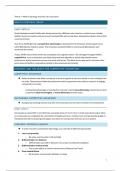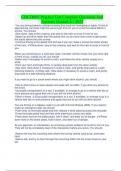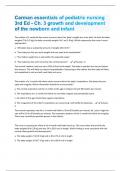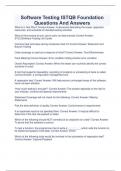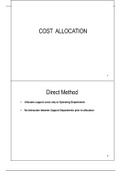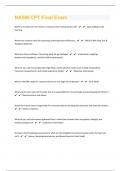Theme 1: What is strategy and why is it important?
WHAT IS STRATEGY ABOUT
EXAM: NETFLIX
Reed Hastings founded Netflix after being inspired by a $40 late return fine for a rented movie. Initially,
Netflix's business model centered around mailing DVDs with no late fees, solving the problem of fines that
customers faced.
Over time, Netflix gained a competitive advantage by being the first to introduce streaming services,
which Blockbuster failed to adopt. This innovation allowed Netflix to outcompete Blockbuster and
dominate the market.
Today, Netflix has evolved further by creating its own original content. This strategy leverages Netflix's
capabilities, such as extensive user data and predictive algorithms, which help identify viewer
preferences and forecast the success of movies and series. This data-driven approach minimizes risks
and enhances Netflix's competitive position in the entertainment industry.
STRATEGY AND THE QUEST FOR COMPETITIVE ADVANTAGE
COMPETITIVE ADVANTAGE
➔ Refers to factors that allow a company to produce goods or services better or more cheaply than
its rivals. These factors allow the productive entity to generate more sales or superior margings
compared to its rivals.
- Competitive advantage is meeting the customer needs more effectively, with products that
customers value more highly, or more efficiently at lower costs.
SUSTAINABLE COMPETITIVE ADVANTAGE
➔ Giving buyers lasting reasons to prefer a firms products or services to those of its competitors
EXAM: APPLE:
Samsung is a competitor in smartphones, but apple does so much more in a few years Samsung or other
pc companies are not going to be competitors of apple anymore, it will be more companies like google or
Facebook that start competing with apple, bcs these are companies who have an eco-system
STRATEGIC APPROACH CHOICES
➔ In order to build a competitive advantage, you can take 4 different approaches
1. Low-cost provider
o Be a low-cost provider (Lidl and Aldi)
2. Differentiation on features
o Differentiate yourself on features: focus lays on uniqueness (Apple)
3. Differentiation market niche
o Focus yourself on a certain market niche (Maserati and Ferrai
4. Cost market Niche
o Be the best-cost provider (Alibaba in china)
1
,THE EVOLVING NATURE OF AN ORGANIZATION’S STRATEGY: DELIBERATENESS VS
EMERGENCE
The evolving nature of an organization’s realized/current strategy is typically a blend of:
PROACTIVE (DELIBERATE)
➔ Strategy elements that include both continued and new initiatives
REACTIVE (EMERGENT)
➔ Strategy elements that are required due to unanticipated competitive developments and fresh
market conditions
EXAM HONDA:
In the 1950s, Honda's intended strategy was to compete with Harley-Davidson in the U.S. market by
introducing large motorcycles. However, this strategy failed due to engineering issues—Honda's bikes
were unsuitable for California's hot climate, which affected their reliability. As a result, Honda struggled to
compete in the established market.
A pivotal moment occurred when a sales manager saw potential in Honda's smaller bikes and decided to
sell them. This led Honda to adopt an emergent strategy, shifting their advertising focus. They targeted a
broader audience, including women, by highlighting that their smaller, more accessible bikes were
suitable for everyone. This approach resonated with the market and became Honda's realized strategy.
This strategic pivot helped Honda capture a previously untapped market, establish itself, and eventually
improve its bikes to compete with larger models. The success story illustrates the importance of
flexibility in adapting to the environment through trial and error. It underscores how Honda's deliberate
strategy evolved into an emergent strategy, ultimately leading to its market
2
,BUSINESS MODEL ELEMENTS
A company’s business model: a value-based strategy
CORE: Increase in willingness to pay and decrease in willingness to supply!
WILLINGNESS TO PAY (WTP)
➔ The value provided to customers
➔ A customer is prepared to pay a certain price for a product
➔ Serving the customer is crucial, bcs this leads to an increase in WTP -> leads to competitive
advantage, wich will eventually give you more profits
WILLINGNESS TO SUPPLY (WTP)
➔ The cost of the supplier
➔ Make it more attractive for vendors and employees to work with the company
➔ Making people wanting to stick by you firm
Increase the whole pie instead of just increasing your own profit, Therefore we have 3 major ‘players’
1. Customer Value Proposition: The value lies between WTP (Willingness to Pay) and price.
Customers feel satisfied when the price is lower than their WTP. Businesses must focus on
meeting customer needs at a price perceived as good value.
2. Value Capturing: The margin between price and cost represents value for the firm. Companies
increase WTP while reducing costs to create and capture value for shareholders.
3. Supplier and Employee Value Proposition: The surplus between compensation (cost) and WTS
(Willingness to Supply) defines satisfaction for suppliers and employees. Organizations must
ensure fair treatment to foster satisfaction and loyalty.
EXAM: VALUE CREATION BY APPLE
Apple pays less rent in the mall then other companies, why? Value creation occurs by increasing WTP
(Willingness to Pay) and decreasing WTS (Willingness to Supply):
3
,IS OUR STRATEGY LIKELY TO BE SUCCESSFUL?
A strategy’s success potential can be evaluated using three tests:
1. Strategic Fit Test:
o Assesses how well the strategy aligns with the firm’s internal resources and external
market conditions.
o External fit ensures alignment with market trends, while internal fit ensures the firm can
competently execute the strategy.
o Example: Apple competing with Nike in shoes lacks strategic fit.
2. Competitive Advantage Test:
o valuates whether the strategy provides a significant and sustainable advantage over
rivals.
o Successful strategies lead to long-term superior performance; failing ones yield only
short-term gains.
3. Performance Test:
o Measures whether the strategy delivers strong organizational performance, using
indicators like profitability, financial strength, and market position.
DEFINING STRATEGY (EXAM!!)
A Strategy is a set of rules that enable the company to make many decisions over a period of time.
A strategy explains how an organization – faced with uncertainty and competition – will achieve superior
performance through value withing a certain business context, improve/sustain the value of the
organization.
➔ A strategy must have a direction, based on a proper diagnosis of the situation (why the challenge
seems difficult). Absent a diagnosis, one cannot judge one’s own choice of an overall guiding
policy (the sources of competitive edge or advantage), much less someone else’s choice. A
strategy must translate overall directive into coordinated action (executing the objectives)
focused on key points of leverage in the situation.
A ”Bad” Strategy?
1. Fluff: “our fundamental strategy is one of customer-centric intermediation”, its fluffy because it
doesn’t say how they are going to make it happen
4
, THE BASIC FRAMEWORK: STRATEGY AS A LINK BETWEEN THE FIRM AND ITS
ENVIRONMENT
In order to have a successful strategy, an organization need to implement 3 ingredients
1. Simple, consistent, long-term goals
- What do you want to achieve
2. Profound understanding of the competitive environment
- Understand what is going on in your industry or the industry you will be active in in the future
- External analysis
3. Objective appraisal of resources
- What could you do? Understand how strong the organization is internally
- Internal analysis
LEVERS OF LEADERSHIP INFLUENCE
A strategy is about the activities an organization performs, where input is transformed into output that
customers are willing to pay for. This process is referred to as operational strategy, which must align with
the corporate and business strategy. The primary activities in the value chain, such as inbound logistics,
operations, outbound logistics, marketing & sales, and service, focus on the "how" and express cost. The
support activities, such as firm infrastructure, HR management, technology development, and
procurement, relate to the price.
There are two key components to strategy:
1. Unique Value Proposition (Price) – This identifies the customers you want to target and sets the
price based on their willingness to pay (WTP). Luxury brands, for example, have a clear idea of
their customer base and their price range.
2. Tailored Value Chain Activities (Cost) – These activities focus on how the firm will deliver on its
promise to customers, focusing on production costs. Companies like Nike design their products
and manage the production and sales process efficiently.
The interaction between value proposition (price) and value chain activities (cost) determines value
capture, leading to economic profitability.
5

